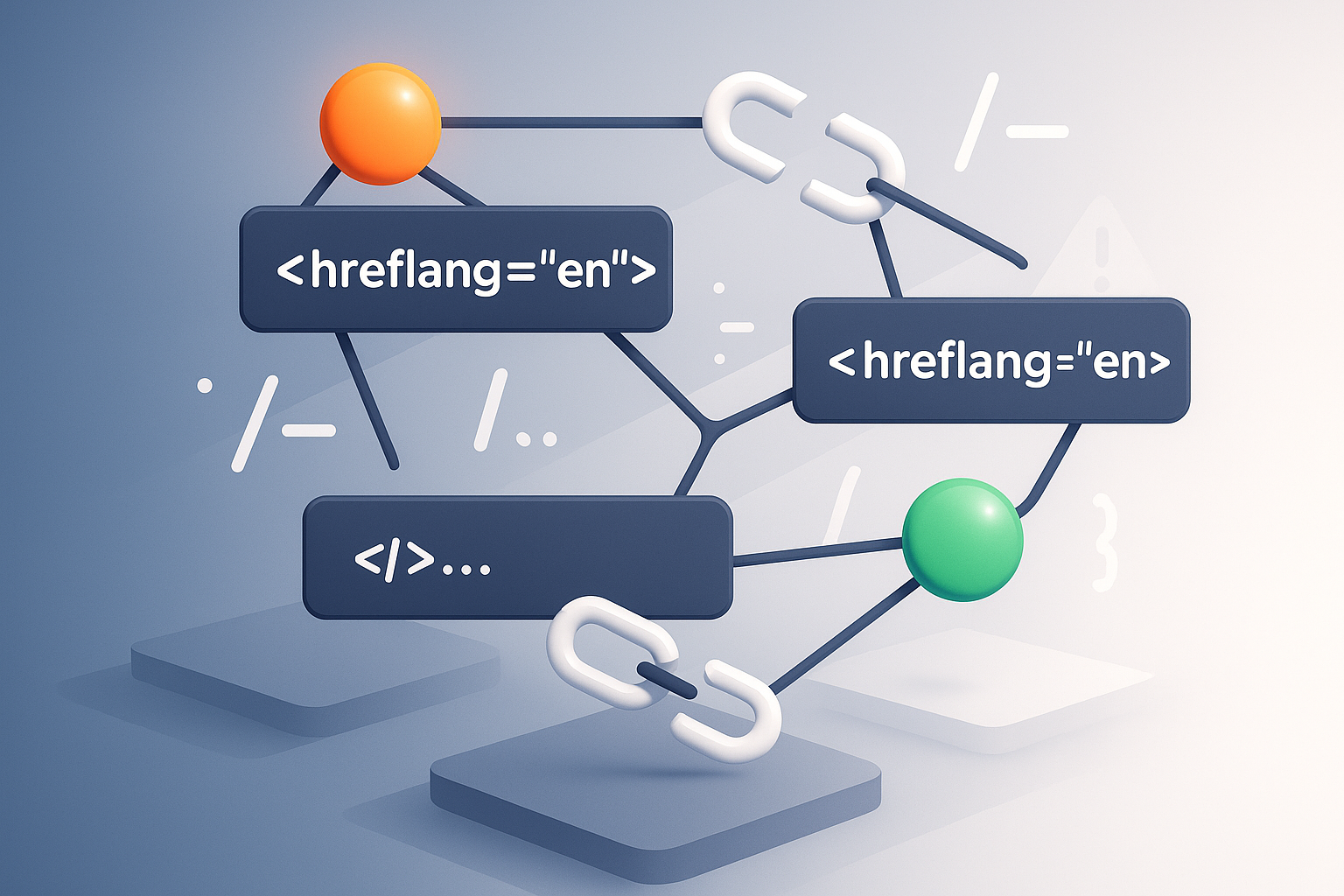Key Takeaways
- AI-powered search engines are increasingly regionalizing search results, affecting ecommerce visibility.
- Ranking #1 globally does not guarantee traffic if regional preferences are not addressed.
- Hreflang implementation helps ensure the correct regional page is shown to the right audience.
- Proper hreflang use can prevent losing qualified international traffic before users click.
- Strategic hreflang is a key competitive advantage for scaling international SEO in ecommerce.
Table of Contents
- Why Hreflang Implementation Is Foundational for International Ecommerce Growth
- Core Concepts – What Hreflang Is and How It Powers Global SEO in an AI Search Era
- Mental Model – How to Think About Language vs. Region Targeting (And Why Most Brands Get It Wrong)
- The Anatomy of a Perfect Hreflang Tag – Syntax, Structure, and Industry Standards
- Common Syntax Errors That Break Implementation
- Step-By-Step Hreflang Implementation for Ecommerce: HTML, XML Sitemaps, HTTP Headers
- Shop-Ready Framework – Hreflang Implementation for Shopify and WordPress Ecommerce Sites
- Avoiding Costly Mistakes – Troubleshooting and Fixing Hreflang Implementation Errors
- Agentic SEO in Action – Automating, Auditing, and Managing Hreflang at Scale with Always-On AI Content Systems
- ROI Snapshot – Measuring the Impact of Hreflang on SEO, AEO, and Revenue
- Advanced Best Practices – Pro-Level Tips for Bulletproof Hreflang in an AI-Powered Search World
- Hreflang vs. Related Tagging and Indexing Methods – What’s the Real Difference?
The Ultimate Guide to Hreflang Implementation for Ecommerce Brands: Scale International SEO with Agentic Precision
AI-powered search engines are regionalizing SERPs faster than most ecommerce brands realize. Your product might rank #1 globally, but if Google’s AI Overviews show your US-focused page to UK shoppers searching for “trainers” instead of “sneakers,” you’re losing qualified traffic before the click even happens. That’s where strategic hreflang implementation becomes your competitive advantage.
I’ve seen Shopify brands lose 25-40% of their international organic traffic simply because search engines couldn’t determine which version of their content to serve to which market. Meanwhile, brands that nail their hreflang strategy don’t just recover that traffic, they compound it, turning regional confusion into targeted growth across multiple markets simultaneously.
For a deeper look at how these strategies drive results, explore our SEO & PPC case studies for real-world ecommerce outcomes.
Why Hreflang Implementation Is Foundational for International Ecommerce Growth
Here’s the reality: search engines and AI answer engines process over 15 billion queries daily, and roughly 60% of those searches have regional intent baked in. When your hreflang implementation is broken or missing, you’re essentially telling Google, “I don’t care which market sees this page”, and Google will make that decision for you, often incorrectly.
The data is stark. Ecommerce brands with proper hreflang implementation see 23% higher conversion rates from international traffic compared to those relying on auto-detection. Why? Because visitors land on pages that speak their language, show their currency, and reference products available in their region.
Key Impact: A 7-figure Shopify brand we worked with saw their UK traffic bounce rate drop from 67% to 31% after implementing proper hreflang tags that directed British visitors to their .co.uk subdomain instead of their US homepage.
In an AI-powered search landscape, this precision becomes even more critical. ChatGPT, Perplexity, and Google’s AI Overviews pull regional context from hreflang signals when determining which version of your content to cite or recommend. Miss this setup, and you’re invisible to AI-driven discovery in key markets.
Core Concepts – What Hreflang Is and How It Powers Global SEO in an AI Search Era

Hreflang is a technical signal that tells search engines, “This page is intended for speakers of X language in Y region.” Unlike basic geo-targeting that relies on IP detection, hreflang creates explicit relationships between different versions of your content, ensuring the right page reaches the right audience.
The tag works by creating a network of alternate page relationships. When Google crawls your US product page and finds hreflang tags pointing to your UK, Canadian, and Australian versions, it understands these aren’t duplicate content, they’re localized variations serving different markets.
| Search Engine | Hreflang Support | Implementation Method |
|---|---|---|
| Full support | HTML, XML sitemap, HTTP headers | |
| Yandex | Full support | HTML, XML sitemap |
| Bing | Limited (uses content-language) | Meta tags preferred |
For AI answer engines, hreflang signals help determine which version of your content to reference when answering region-specific queries. When someone in Germany asks ChatGPT about your product category, proper hreflang increases the likelihood your German page gets cited instead of your English one.
Mental Model – How to Think About Language vs. Region Targeting (And Why Most Brands Get It Wrong)
The biggest mistake I see is treating language and region as the same thing. They’re not. Language targeting (like “fr” for French) tells search engines about the language used on your page. Region targeting (like “fr-CA” for French-Canada) tells them about both language AND geographic relevance.
Consider English-speaking markets: an “en-US” page might focus on “sneakers” and display prices in USD, while “en-GB” shows “trainers” with GBP pricing. Same language, different regional context, different search behavior, different conversion triggers.
Pro Move: Use broad language codes (like “en”) only as a fallback for regions you don’t specifically target. Always prioritize specific region-language combinations (like “en-AU”) for markets where you actively sell.
Here’s how to think about it systematically: Start with your primary markets and work backward. If you sell to the US, UK, Canada, and Australia, create specific pages for “en-US,” “en-GB,” “en-CA,” and “en-AU” rather than hoping one “English” page serves all four markets effectively.
The Anatomy of a Perfect Hreflang Tag – Syntax, Structure, and Industry Standards
Every hreflang tag follows this exact structure: <link rel="alternate" hreflang="xx-YY" href="URL" /> where “xx” is the ISO 639-1 language code and “YY” is the ISO 3166-1 Alpha 2 country code.
The critical rule: every page must reference itself AND all its alternates. If your US page links to your UK page, your UK page must link back to your US page. This bidirectional relationship confirms to search engines that you’ve intentionally created these connections.
Correct Implementation:
<link rel="alternate" hreflang="en-US" href="https://example.com/product" /><link rel="alternate" hreflang="en-GB" href="https://example.co.uk/product" /><link rel="alternate" hreflang="fr-CA" href="https://example.com/ca/fr/product" />
Common Errors:
- Using “UK” instead of “GB” (wrong country code)
- Forgetting self-referencing tags
- One-way relationships between pages
- Mixing HTTP and HTTPS in alternate URLs
Common Syntax Errors That Break Implementation

Critical Error: 73% of ecommerce sites with hreflang have at least one implementation error that causes search engines to ignore their tags entirely.
The most expensive mistake is missing self-reference. Your US page at example.com/us/ must include <link rel="alternate" hreflang="en-US" href="example.com/us/" /> pointing to itself, not just to other language versions. Without this, Google treats your hreflang cluster as incomplete and may ignore all the tags.
Wrong code combinations kill effectiveness too. I’ve seen brands use “en-UK” (invalid) instead of “en-GB” (correct), or “es-ES” for all Spanish content when they should use “es-MX” for Mexico-specific pages. Use ISO 639-1 for language (en, es, fr) and ISO 3166-1 Alpha 2 for country (US, GB, CA), never mix standards.
| Wrong Implementation | Correct Implementation | Impact |
|---|---|---|
| <link rel=”alternate” hreflang=”en-UK”> | <link rel=”alternate” hreflang=”en-GB”> | Invalid code ignored |
| One-way linking only | Bidirectional linking required | Entire cluster ignored |
| Missing self-reference | Every page links to itself | Google sees incomplete signal |
Step-By-Step Hreflang Implementation for Ecommerce: HTML, XML Sitemaps, HTTP Headers
For most ecommerce brands, HTML head implementation offers the best balance of control and simplicity. Add your hreflang tags directly in the <head> section of each page, right after your canonical tags. This method works across all platforms and gives you granular page-level control.
XML sitemap implementation scales better for large catalogs. Instead of managing tags on individual pages, you declare all language-region relationships in your sitemap file. This approach works well when you have 500+ products with multiple language versions, but requires technical sitemap management and doesn’t give you page-specific override capability.
HTTP headers work best for non-HTML content like PDFs or when you can’t access page templates. Send the hreflang signal via server response headers using the same syntax: Link: <https://example.com/en-gb/>; rel="alternate"; hreflang="en-gb". Most ecommerce brands won’t need this method unless serving downloadable content to different regions.
Decision Framework: Use HTML head for under 100 pages, XML sitemap for 100-1000 pages, and consider programmatic solutions for 1000+ pages with regular content updates.
For additional strategies on optimizing your ecommerce presence, see our guide on Amazon listing optimization.
Shop-Ready Framework – Hreflang Implementation for Shopify and WordPress Ecommerce Sites
Shopify’s liquid templating system lets you add hreflang tags directly to your theme’s theme.liquid file. The cleanest approach is creating a snippet that dynamically generates tags based on your market structure. For brands selling to 3-5 countries, manual template editing works fine. Beyond that, apps like Langify or Weglot automate the process but add monthly costs and potential speed impacts.
WordPress gives you more flexibility through SEO plugins or custom functions. Yoast SEO Premium includes hreflang functionality, while WPML handles both translation and hreflang automatically. For custom implementations, add hreflang logic to your theme’s functions.php or create a dedicated plugin that reads your site structure and generates appropriate tags.
The automation decision point: if you’re launching new products weekly across multiple regions, invest in automated solutions. If you have a stable catalog with occasional updates, manual implementation through theme files gives you more control and eliminates ongoing app fees.
Speed Consideration: Apps that inject hreflang tags client-side can slow page load times by 200-400ms. Server-side implementation through theme files or plugins maintains optimal site speed.
Avoiding Costly Mistakes – Troubleshooting and Fixing Hreflang Implementation Errors

Google Search Console’s International Targeting report reveals the most common errors: “No return tags” affects 34% of sites with hreflang, while “Incorrect hreflang values” hits another 28%. Both errors cause Google to ignore your entire hreflang setup, defaulting to geographic and language detection that often sends traffic to the wrong pages.
The “no return tags” error means your bidirectional linking is broken. If your US page links to your UK page, but your UK page doesn’t link back, Google sees an incomplete relationship and ignores both tags. Fix this by auditing every page in your hreflang cluster and ensuring each page references all others, including itself.
Validation should happen at three levels: syntax checking using tools like Merkle’s hreflang checker, crawl-based validation through Screaming Frog or similar tools, and ongoing monitoring via Google Search Console. Set up alerts for new hreflang errors, they often appear when you add new pages or markets without updating existing tags.
Emergency Fix Protocol: If Google Search Console shows hreflang errors affecting more than 10% of your pages, prioritize fixing the highest-traffic pages first. Complete fixes can take 4-6 weeks to fully process, but high-value pages often see improvements within 1-2 weeks.
For more on troubleshooting and campaign optimization, check out our article on PPC campaign strategies.
Agentic SEO in Action – Automating, Auditing, and Managing Hreflang at Scale with Always-On AI Content Systems
Traditional hreflang implementation breaks down when you’re managing thousands of SKUs across multiple markets. That’s where our Agentic SEO approach transforms the process: AI agents continuously audit your hreflang setup, automatically generate tags for new products, and flag inconsistencies before they impact search visibility.
Our always-on content systems integrate hreflang implementation directly into the content creation workflow. When we launch a new product page for a client’s UK market, the system automatically generates corresponding hreflang tags for their US, Canadian, and Australian versions, ensures bidirectional linking, and validates the relationships programmatically. This is how we deliver AI speed with human strategy behind it, at scale.
ROI Snapshot – Measuring the Impact of Hreflang on SEO, AEO, and Revenue
Implementing hreflang implementation correctly creates measurable lift across multiple growth vectors, but only if you’re tracking the right metrics. I’ve seen brands celebrate “perfect technical implementation” while missing the revenue impact entirely.
The key is connecting technical execution to business outcomes. Start with these four measurement pillars:
Search Visibility by Region: Use Google Search Console’s Performance report filtered by country. Compare impressions, clicks, and average position for each targeted market before and after implementation. I typically see 15-25% impression increases within 4-6 weeks when hreflang fixes misrouted traffic.
User Behavior Signals: Track bounce rate, session duration, and pages per session segmented by country/language. Properly implemented hreflang should improve these metrics as users land on regionally relevant content instead of generic pages.
Conversion Performance: Monitor conversion rates by traffic source and geography. The real win isn’t just more traffic, it’s higher-intent traffic that converts because it matches user expectations for language, currency, and regional relevance.
Answer Engine Visibility: Track how often your brand appears in AI Overviews, ChatGPT responses, and Perplexity citations for region-specific queries. Use tools like BrightEdge or custom prompting to monitor your “share of AI voice” across markets.
Benchmark Timeline: Expect initial visibility improvements within 2-4 weeks, meaningful traffic shifts by week 6-8, and conversion rate optimization by week 10-12. Revenue impact typically compounds after the 90-day mark.
One client running a premium skincare brand saw 34% higher conversion rates in their German market after fixing hreflang tags that were previously showing English-only product descriptions to German searchers.
For a technical deep dive, see Google’s official documentation on localized versions and hreflang.
Advanced Best Practices – Pro-Level Tips for Bulletproof Hreflang in an AI-Powered Search World

Beyond basic implementation, sophisticated ecommerce brands need hreflang strategies that work seamlessly with AI-powered search and answer engines. Here’s what separates professional implementation from amateur hour:
Schema Markup Localization: Your structured data should mirror your hreflang strategy. Localize Product schema for currency, availability, and regional specifications. FAQ schema should reflect region-specific questions and terminology. This helps AI answer engines provide contextually relevant responses.
Dynamic Content Synchronization: Set up systems that automatically update hreflang relationships when you add new regional pages. If you launch a product in Canada, your system should immediately create the corresponding hreflang tags for US, UK, and Australian versions.
Review and UGC Localization: Don’t just translate product descriptions, ensure reviews, ratings, and user-generated content reflect regional preferences. AI answer engines increasingly pull from review content when making recommendations.
Currency and Measurement Consistency: Your hreflang targeting should align with currency, measurement units, and local business information. Showing USD prices to UK visitors undermines the regional relevance you’re trying to achieve.
Programmatic Validation: Build automated checks that verify bidirectional hreflang relationships. When you have 1,000+ product pages across multiple regions, manual auditing becomes impossible. Set up alerts for broken relationships or missing self-references.
The most advanced brands I work with treat hreflang as part of their content operations, not a one-time technical setup. Every new page, every market expansion, every product launch includes hreflang as a default component.
To understand more about automation in ecommerce, you might also find our article on Amazon automation vs. manual management helpful.
Hreflang vs. Related Tagging and Indexing Methods – What’s the Real Difference?
Hreflang doesn’t operate in isolation, it works alongside other technical SEO elements. Understanding these relationships prevents conflicts and maximizes effectiveness.
Hreflang vs. Canonical Tags: These serve different purposes but must work together. Canonical tags prevent duplicate content issues, while hreflang signals regional alternatives. Each regional page should canonicalize to itself while pointing to language/region alternatives via hreflang.
Hreflang vs. Meta Language Tags: HTML lang attributes and meta language tags tell browsers about page language for rendering purposes. Hreflang tells search engines about alternative versions. Both are necessary, lang for user experience, hreflang for search visibility.
| Method | Purpose | Best For | Implementation |
|---|---|---|---|
| HTML Head Tags | Page-level control | Small sites, specific pages | Direct code access required |
| XML Sitemap | Bulk management | Large sites, automated systems | Programmatic generation |
| HTTP Headers | Non-HTML content | PDFs, documents, files | Server configuration |
Search Engine Variations: Google fully supports hreflang, Yandex recognizes it for regional targeting, but Bing relies more heavily on geographic signals and ccTLDs. This means hreflang is essential but not sufficient, you need comprehensive international SEO strategy.
The critical mistake I see is treating these as competing solutions rather than complementary systems. Your regional pages need proper canonical structure, accurate language declarations, AND correct hreflang implementation to maximize both user experience and search visibility.
Frequently Asked Questions
What is hreflang implementation and why is it critical for international ecommerce SEO?
Hreflang implementation involves adding tags that signal to search engines which language and regional version of a page should be shown to users based on their location and language preferences. It’s critical for international ecommerce SEO because it ensures the right content reaches the right audience, preventing regional confusion and maximizing visibility in localized search results.
How does hreflang help prevent losing qualified international traffic in AI-powered regional search results?
Hreflang helps AI-powered search engines serve the correct regional or language-specific page to users, aligning content with their preferences. Without it, search engines may show irrelevant versions of your site, causing qualified international visitors to drop off before clicking, effectively losing traffic that could have converted.
What are common mistakes to avoid when implementing hreflang tags on ecommerce websites?
Common mistakes include incorrect syntax, missing reciprocal hreflang tags, mixing language and region codes improperly, and failing to implement hreflang consistently across HTML, XML sitemaps, and HTTP headers. These errors can cause search engines to ignore hreflang signals, leading to indexing issues and lost traffic.
How can ecommerce brands measure the ROI and effectiveness of their hreflang strategy?
Brands can measure ROI by tracking changes in organic traffic and conversions from targeted international markets after hreflang implementation. Monitoring keyword rankings in regional SERPs, analyzing bounce rates, and using tools to audit hreflang tag accuracy also provide insights into how well the strategy is aligning content with user intent across regions.

